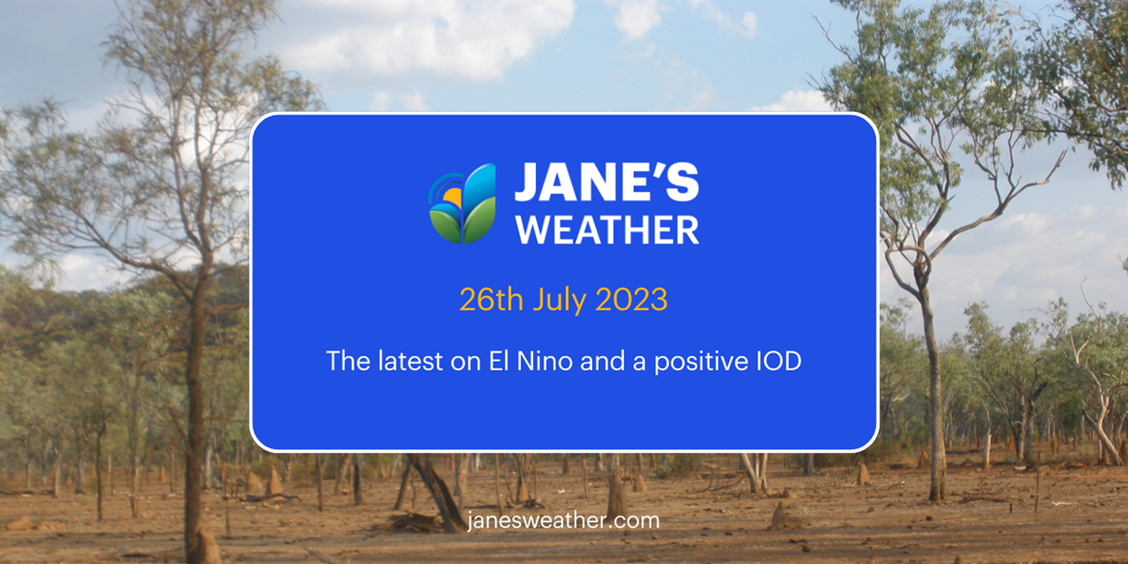Mixed outlook as we head into Christmas
We have a brief burst of heat in the southeast, followed by showers and storms to the east of the trough which brings a cool change.

We are nearing the end of July, firmly half way through the year, and that gives greater insight into whether 2023 will indeed be known as an El Nino year, with effects in Australia over spring and summer.
We’re also halfway through the period that the Indian Ocean Dipole (IOD) can have an impact on our weather.
Sea temperatures
The following map shows the current state of play.
We focus on the two boxed areas to determine what the oceans impact is on the overall ocean and atmosphere interaction.
 Above: Sea Surface Temperature Anomaly (how much warmer or cooler than average).
Above: Sea Surface Temperature Anomaly (how much warmer or cooler than average).
Pacific Ocean
Looking at the Pacific Ocean, where the boxed area is firmly yellow, with reds gradually increasing from week to week.
That is the first sign that El Nino is developing… but it’s only one piece of the puzzle.
We also need the water off Queensland to cool down and turn blue on this map - and that hasn’t occurred yet.
Thirdly, we need the atmosphere to pick up on this difference and start pushing moist air away from Australia - that also hasn’t occurred yet.
There is a tropical pulse that works its way around the globe, currently near Queensland (bringing the latest burst of rain there). That pulse is projected to move into the western Pacific and could be the catalyst to push the atmosphere into the new phase.
That could be the trigger that properly kicks off El Nino.
The boxed area crossed the threshold back in early June (when the Americans and WMO declared El Nino) and every single global weather model is projecting the boxed area to remain warmer than average into early 2024.
All guidance points towards a Pacific Ocean set up that pushes moisture away from Australia over spring and summer.
 Above: Pacific Ocean - observations (black line) and projections (coloured lines) for the temperature of the boxed area.
Above: Pacific Ocean - observations (black line) and projections (coloured lines) for the temperature of the boxed area.
Indian Ocean
Looking at the Indian Ocean, where the boxed area is predominantly yellow, with a hint of blue in the northwest corner.
That is the first sign that a positive IOD is developing (there’s no fancy name in the Indian Ocean, it’s just positive or negative).
This ocean has been trying to go into positive for much of autumn and winter… but each time it approached the threshold it fell away again before crossing over.
For the index to cross the threshold we also need the water off Indonesia to cool down and turn blue on the map - and that has only partially occurred. We need the water to the west of Indonesia to also turn blue.
Then we need the atmosphere to pick up on this difference and start pushing moist air away from Australia.
This ocean also has every single global weather model projecting the boxed area to remain warmer than average until the end of the year - and in the past few weeks the index has started to climb once again.
All guidance points towards an Indian Ocean set up that pushes moisture away from Australia over spring, and potentially late winter too.
 Above: Indian Ocean - observations (black line) and projections (coloured lines) for the temperature of the boxed area.
Above: Indian Ocean - observations (black line) and projections (coloured lines) for the temperature of the boxed area.
See when the rain is most likely at your property, hour by hour for the next ten days, along with our customisable insights highlighting the impacts on your operations, with our precise and actionable forecasts at Jane’s Weather. Don’t miss our new simplified view to quickly understand the outlook.
Sign up for personalised alerts to stay ahead of what weather is on its way.
Our notifications include temperatures, rain and wind, along with evapotranspiration, frost risk, growing degree days and a spraying forecast, customised for any property in Australia.
Posts By Tag

We have a brief burst of heat in the southeast, followed by showers and storms to the east of the trough which brings a cool change.

We've moved into a phase of weather with limited connection to tropical moisture, an ending Negative Indian Ocean Dipole, and a weak La Nina - so...

The leftover moisture from Cyclone Fina is meeting up with a trough over the centre of the country and it is set to spread significant rain...